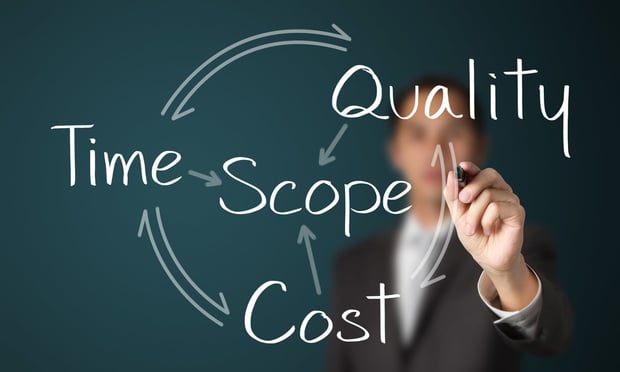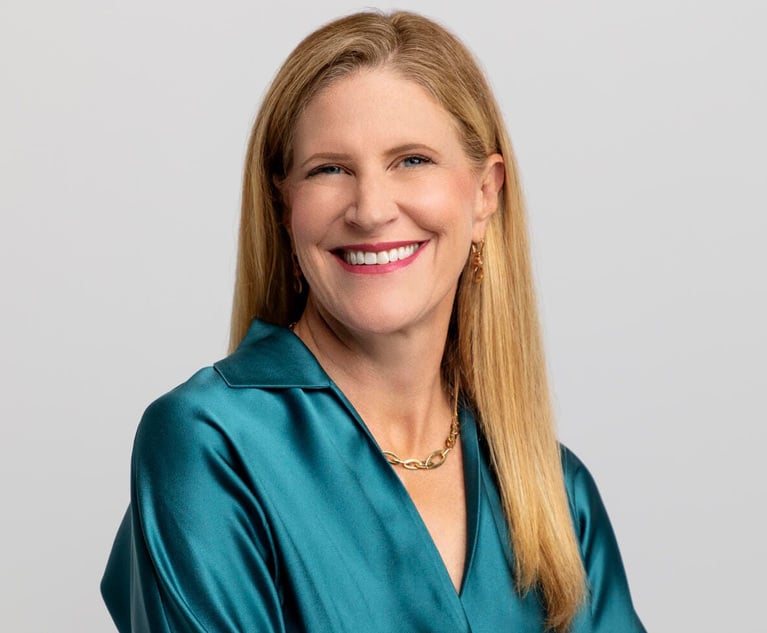General Counsel Need to Seek Flat Fees More, Research Finds
In the first key finding of its GC Thought Leaders Experiment, AdvanceLaw assesses whether flat fees generate better or worse law firm performance on legal matters than do hourly fees.
December 24, 2018 at 11:19 AM
10 minute read
The original version of this story was published on The American Lawyer

We have all heard a lot about how various fee arrangements, especially flat fees, are going to overtake the legal industry. In recent years, several sophisticated legal departments have largely committed to using alternative fees with their law firms. Yet flat fees are not close to unseating the ingrained law firm practice of hourly billing. If flat fees are clearly better—as we've been hearing from advocates for 15 years or more—then why is hourly billing so alive and well?
Sure, law firm economics are a part of it—under flat fees, firms bear the cost of any inefficiency. Another reason is that old habits die hard. Within the legal industry, and beyond, even the best ideas can take a shockingly long time to catch on. (For more on this point, we recommend Bill Henderson's writings on the diffusion of innovations and Casey Flaherty's colorful pieces on the slow adoption of superior technologies.) That said, perhaps an even bigger reason for the plodding rise of flat fees is that no one has answered the most important question of all: do flat fees actually work?
Some general counsel with whom we partner through AdvanceLaw (a closed market where member GCs share performance data to select outside counsel) swear by flat fees, while others are reluctant to take the plunge. Critics note that while flat fees provide budget predictability, firms will price them with a cushion, which raises total cost. Worse, some GCs worry their law firm may staff flat fee matters with “the B team” because revenue for the firm is assured, no matter the quality or outcome. In fact, we recently asked a room of in-house counsel from different companies what kept them from using flat fees more. The top answer, cited by 49 percent, was a concern that quality would suffer if a flat fee were used. (Coming in second, at 33 percent, was that law firms were not proposing them often enough.)
So, does quality of work suffer when law firms work on a flat fee? It seems like we should know this already, as the industry has been talking about flat fees for so long, but all we know is either anecdotal or from opinion surveys. The GC Thought Leaders Experiment looks at in-house satisfaction (with cost, quality, responsiveness, expertise, etc.) on actual legal work performed—so it is designed to teach us more than an opinion survey ever could. The research analyzes the differences between matters that earn high scores and those with low scores, using regression analysis. The goal is to better understand one big question: Which law firm and client practices actually result in great legal work?
In this article, we address whether flat fees generate better or worse law firm performance on legal matters than do hourly fees. We learned some surprising and exciting things.
Inquiry 1: What is the Effect of Flat Fees on Cost and Quality?
We'll start with the punchline. Based on our examination of 1,400 legal matters, across 400 law firms and 28 of our clients (e.g., Mastercard, Keurig, Nike, Molson Coors, Panasonic—the full list of clients participating in The Experiment is here) we found that flat fees do in fact reduce client cost, and they don't hurt or help quality. In a word, flat fees work.
First, let's look at cost. We know whether each of the legal matters examined was on a flat or hourly fee. We also know how the client assessed the cost effectiveness of the representation. So we looked to see whether the matters on an hourly fee were more or less cost-effective than the matters on a flat fee. (We did not compare dollar costs because the matters were not identical.)
Across this large group of legal matters, flat fees consistently delivered better cost-effectiveness than hourly rates. The mean scores were 4.34 and 4.21 (of 5), respectively. While these differences appear small, they are statistically significant to a 95 percent confidence level, controlling for other variables. Driving a good portion of these performance gaps is the much higher likelihood that a matter handled on an hourly rate will greatly disappoint on cost. For example, clients rated 5 percent of all hourly matters poorly for cost effectiveness (i.e., 2 or lower), compared with just 1 percent of flat-fee matters. Put another way, only one out of 100 flat-fee matters performed poorly on cost-effectiveness, versus one in 20 for hourly fees.
Interestingly, fixed fees for portfolios of work earn even higher scores on cost effectiveness. However, this is not statistically significant, as we are working off a smaller data set; only 1.5 percent of the 1,400 legal matters were on a fixed fee for a portfolio of work.
An interesting and related piece of analysis: we wanted to see whether GCs who think that flat fees are working well in their departments (i.e., their opinion of flat fees is high) are actually correct. Are their in-house lawyers more satisfied with cost effectiveness (for work on a flat fee) than other departments where GCs don't believe in flat fees? Not only is the answer no, in-house lawyers whose GCs think highly of flat fees actually have slightly lower satisfaction on flat fees than in-house lawyers on other teams (though this difference is not statistically significant). All of this underscores just how unreliable opinion survey data is. Another way to say this—GCs don't even know whether flat fees work in their own law departments.
Getting back to the main point, in the aggregate flat fees do in fact outperform hourly fees on cost-effectiveness. This was not a given, as many clients suspect law firms price flat fees with a cushion. But of course, the really big fear about flat fees relates to quality of service. To get at this, we measured in-house counsel's perception of law firm responsiveness, quality of work, legal expertise, solutions focus, and several other variables that speak to service quality across our data set of 1,400 legal matters. As noted above, legal matters on a flat fee do not necessarily score higher or lower on these service quality metrics than hourly fees. We did not find any statistically significant relationship. So, on average, across our data set, service quality is the same under flat fees, and clients are happier with their bills.
But there is an important follow up question: “When do flat fees work best?”
Inquiry 2: What Makes Flat Fees Work?
There is a widely held sentiment that flat fees work only within the confines of a trusting, long-term client-firm relationship. This sounds sensible and is pretty hard to argue against. Our data suggest otherwise—we did not find that the length of the client-firm relationship (or the amount of trust a GC has in a firm, or the amount of spend with a firm) improved the efficacy of flat fees. This, we think, is very important as we think about flat fee adoption, because clients and law firms often point to the need for a perfect, trusting relationship as an obstacle to trying out flat fees in the first place.
We should note that this comports with our overall experience at AdvanceLaw. When we look across our GCs' matters and portfolios in our core business (where the GCs are largely moving work to new law firms), a meaningful proportion of the work is on a flat fee. And, on balance, we have witnessed especially strong client satisfaction on cost and quality alike.
That said, and looking at the data set again, we find one factor matters much more than the rest: in-house experience using flat fees. Departments that use flat fees with greater frequency do achieve better results (on both cost and quality). We feel this is an important finding because some in-house lawyers who try flat fees are likely to be abandoning them prematurely, as the greatest returns come from practice and experimentation. This knowledge may encourage more clients to make a more concerted effort to embrace and experiment with flat fees.
More specifically, when we look at clients using flat fees for matters (or fixed fees for portfolios) for 30 percent or more of their legal work versus clients using them for less than 30 percent of their legal work, the more experienced group does meaningfully better with flat fees. They achieve greater cost-effectiveness on their flat fees (though not statistically significant), and better service quality metrics, especially responsiveness (4.61 vs. 4.39 out of 5) and likelihood to recommend the lawyer (8.53 vs. 7.99 out of 10), both statistically significant. Clients with more flat fee experience also see improvements in law firm solutions focus and in outcome of legal matters under a flat fee.
All this relates to another finding: flat fees are not used nearly as much as one might think.
Inquiry 3: How Much And For What Are Flat Fees Used?
In our cross-section of 1,400 legal matters, just 18.4% were billed on non-hourly (principally flat) fee structures. This is a bit lower than one might expect given their efficacy and all we read about flat fees. Perhaps this low rate of use relates to the fact that, as an industry, we have lacked meaningful data on whether they actually work. And, to the point just above, in-house lawyers may be giving up on them too early because of poor performance—when in fact the return on investment for flat fees increases with practice.
It may also be helpful for clients and law firms to know in which legal areas clients are most likely to retain law firms under a flat fee. The top three legal areas, in descending order, are: intellectual property (22.5 percent of flat fees), labor and employment (13.3 percent), and M&A (10.2 percent). Across all flat fee matters, 17 percent are litigation (and 83 percent are non-litigation). When we publish our final study—the Thought Leaders Experiment is in progress and we are collecting more data—we will provide tables with more detailed and granular data in this and other areas.
Conclusion
To summarize the above findings: flat fees reduce cost, they don't affect quality, and they don't require long or trusting relationships. Perhaps most importantly, those who use flat fees regularly get better at using them. The flat fee is a tool that becomes more effective with deeper and broader adoption.
This suggests that flat fees should be used more than they are—not just because of their performance, but because of their potential. Is the flat fee innovation here to stay? We think so: flat fees, like other alternatives to hourly billing, are good—and getting better.
Michael Williams is CEO of AdvanceLaw and Aaron Kotok is managing director.
NOT FOR REPRINT
© 2025 ALM Global, LLC, All Rights Reserved. Request academic re-use from www.copyright.com. All other uses, submit a request to [email protected]. For more information visit Asset & Logo Licensing.
You Might Like
View All
Ex-Marathon General Counsel Takes Legal Reins of Another Energy Company

Former Capital One Deputy GC Takes Legal Reins of AIG Spinoff

Legal Departments Dinged for Acquiescing to Rate Hikes That 'Defy Gravity'
4 minute readTrending Stories
- 1Former Sacks Weston Partner Faces 5-Year Suspension Over Mail, Wire Fraud Conviction
- 27th Circ. Revives Transactional Dispute Against Military Retailer, Sends to State Court
- 3Lavish 'Lies' Led to Investors Being Fleeced in Nine-Figure International Crypto Scam
- 4AstraZeneca Files Flurry of Lawsuits to Protect Cancer Treatment Drug
- 5American Airlines Legal Chief Departs for Warner Bros. Discovery
Who Got The Work
Michael G. Bongiorno, Andrew Scott Dulberg and Elizabeth E. Driscoll from Wilmer Cutler Pickering Hale and Dorr have stepped in to represent Symbotic Inc., an A.I.-enabled technology platform that focuses on increasing supply chain efficiency, and other defendants in a pending shareholder derivative lawsuit. The case, filed Oct. 2 in Massachusetts District Court by the Brown Law Firm on behalf of Stephen Austen, accuses certain officers and directors of misleading investors in regard to Symbotic's potential for margin growth by failing to disclose that the company was not equipped to timely deploy its systems or manage expenses through project delays. The case, assigned to U.S. District Judge Nathaniel M. Gorton, is 1:24-cv-12522, Austen v. Cohen et al.
Who Got The Work
Edmund Polubinski and Marie Killmond of Davis Polk & Wardwell have entered appearances for data platform software development company MongoDB and other defendants in a pending shareholder derivative lawsuit. The action, filed Oct. 7 in New York Southern District Court by the Brown Law Firm, accuses the company's directors and/or officers of falsely expressing confidence in the company’s restructuring of its sales incentive plan and downplaying the severity of decreases in its upfront commitments. The case is 1:24-cv-07594, Roy v. Ittycheria et al.
Who Got The Work
Amy O. Bruchs and Kurt F. Ellison of Michael Best & Friedrich have entered appearances for Epic Systems Corp. in a pending employment discrimination lawsuit. The suit was filed Sept. 7 in Wisconsin Western District Court by Levine Eisberner LLC and Siri & Glimstad on behalf of a project manager who claims that he was wrongfully terminated after applying for a religious exemption to the defendant's COVID-19 vaccine mandate. The case, assigned to U.S. Magistrate Judge Anita Marie Boor, is 3:24-cv-00630, Secker, Nathan v. Epic Systems Corporation.
Who Got The Work
David X. Sullivan, Thomas J. Finn and Gregory A. Hall from McCarter & English have entered appearances for Sunrun Installation Services in a pending civil rights lawsuit. The complaint was filed Sept. 4 in Connecticut District Court by attorney Robert M. Berke on behalf of former employee George Edward Steins, who was arrested and charged with employing an unregistered home improvement salesperson. The complaint alleges that had Sunrun informed the Connecticut Department of Consumer Protection that the plaintiff's employment had ended in 2017 and that he no longer held Sunrun's home improvement contractor license, he would not have been hit with charges, which were dismissed in May 2024. The case, assigned to U.S. District Judge Jeffrey A. Meyer, is 3:24-cv-01423, Steins v. Sunrun, Inc. et al.
Who Got The Work
Greenberg Traurig shareholder Joshua L. Raskin has entered an appearance for boohoo.com UK Ltd. in a pending patent infringement lawsuit. The suit, filed Sept. 3 in Texas Eastern District Court by Rozier Hardt McDonough on behalf of Alto Dynamics, asserts five patents related to an online shopping platform. The case, assigned to U.S. District Judge Rodney Gilstrap, is 2:24-cv-00719, Alto Dynamics, LLC v. boohoo.com UK Limited.
Featured Firms
Law Offices of Gary Martin Hays & Associates, P.C.
(470) 294-1674
Law Offices of Mark E. Salomone
(857) 444-6468
Smith & Hassler
(713) 739-1250







